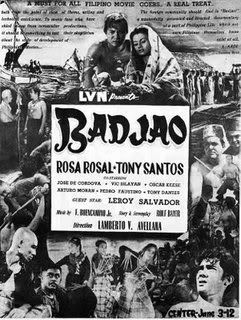"No medium has had more impact on the 20th century culture
than the motion picture. The meanings and
themes of films are endlessly analyzed and debated, styles and
techniques of filmmakers are earnestly dissected and studied,
and the actors and actresses who star in movies live their
public lives in fishbowls."
-- Barbara and David P. Mikkelson,
Urban Legends References, 2005
Motion picture as an art and as an enterprise has been permanently established in the Philippines. The Philippines was one of the countries in Asia who ventured in moviemaking. The industry was the offshoot of the Zarzuela, the vaudeville and the stage shows. In 1919, Jose Nepomuceno, a wealthy businessman, ventured into the film industry and directed the first Filipino film entitled "Dalagang Bukid". (Source: Motion Pictures in the Philippines, Vicente Salumbides, 1952) This was when Philippine Cinema began.

Our movies say a lot about
what we are as a people. The characters we see on the silver screen often serves as our role models and our inspiration. Thus, it is sad to think that our industry is alrea
dy in a declining stage. Before the Second World War, theatre sprouted out and most of these were American theatres (State, Lyric, Galaxy, etc.) But only two theatres catered to the Philippine movies. Dalisay and Life. Unfortunately, film producers cannot make more films because they cannot be accomodated by two theatres. That is why the Philippine movie industry did not grow as fast as the modern films and at the same time, foreign technology were growing at a turtleneck pace. Foreign Film Technology is growing by leaps and bounce while we are still in the infancy stage. (Source: Dona Sisang and Filipino Movies, Monina A. Mercado, 1977; Picture taken from: http://senorenrique.blogspot.com)
Although the Big 4 productions namely: the Vera-Perez' Sampaguita, Dona Sisang's LVN, Lebran Studios and the Santiago's Premiere Production tried their best to cope up, still cannot compete with foreign films abroad but also technicians and consultants. That is why our films are more costly than foreign films. (Source: Motion Pictures in the Philippines, Vicente Salumbides, 1952)
In spite of all the problems, we have produced good movies that even won in film festivals. According to Carmelita Masigan, "In the constantly changing world of the Filipino film industry, film festivals have become windows through which the Philippines lets the world see its screen images". There has been a number of locally produced films that have received international recognition.
Beginning from the Golden Age were the famous:


Anak Dalita (1956) and Badjao (1957) was LVN's pride because they were the first Filipino films that were screened at the Asian Film Festival.
(Source: http://video48.blogspot.com and 100 Acclaimed Tagalog Movies by Mel Tobias, 1998)
Factors why the world saw the country's potential growth for films was that actors and actresses were disciplined and practiced professionalism. This also improved employment by creating more jobs for Filipinos. But most of all, it gave the Filipinos identity, nationalism and lesson to improve life.
Today, in spite of all this, producers have shied away from producing good-quality movies due to these factors:
1. Escalating costs of film production
2. Exorbitant taxes
3. Falling box-office receipts/domestic films to bigger budgeted films
4. FILM PIRACY (Please.. we have got to stop doing this to our movies)
5. Film censorship
6. Star syndrome
7. Cable television
(Source: http://www.pia.gov.ph/)
Therefore almost everybody resorted into sex, crime and violence, which was the trend in moneymaking films.
You know, we could produce good movies that can compete in the world market. Just like the Golden days, we have good actors, actresses, directors, cinematograhers and scriptwriters.
"What could help solve the ills of the industry is for
Filipino producers to branch out into the world market"
-- Kane Lynn, Can Filipino Films Sell Abroad, Mirror Magazine, 1965)
This was said 43 years ago. If only there will be mre government support incentives, produce classic film festivals in comparison to the annual MMFF to acknowledge and give recognition to the film industry that once brought prestige to our country, this in return can promote Filipino movies and once again become one of our highly income export that will help us rise from this economic crisis.
So i'm going to stop here because I don't want to post everything in one entry. :)
Til next time,
Justine


No comments:
Post a Comment